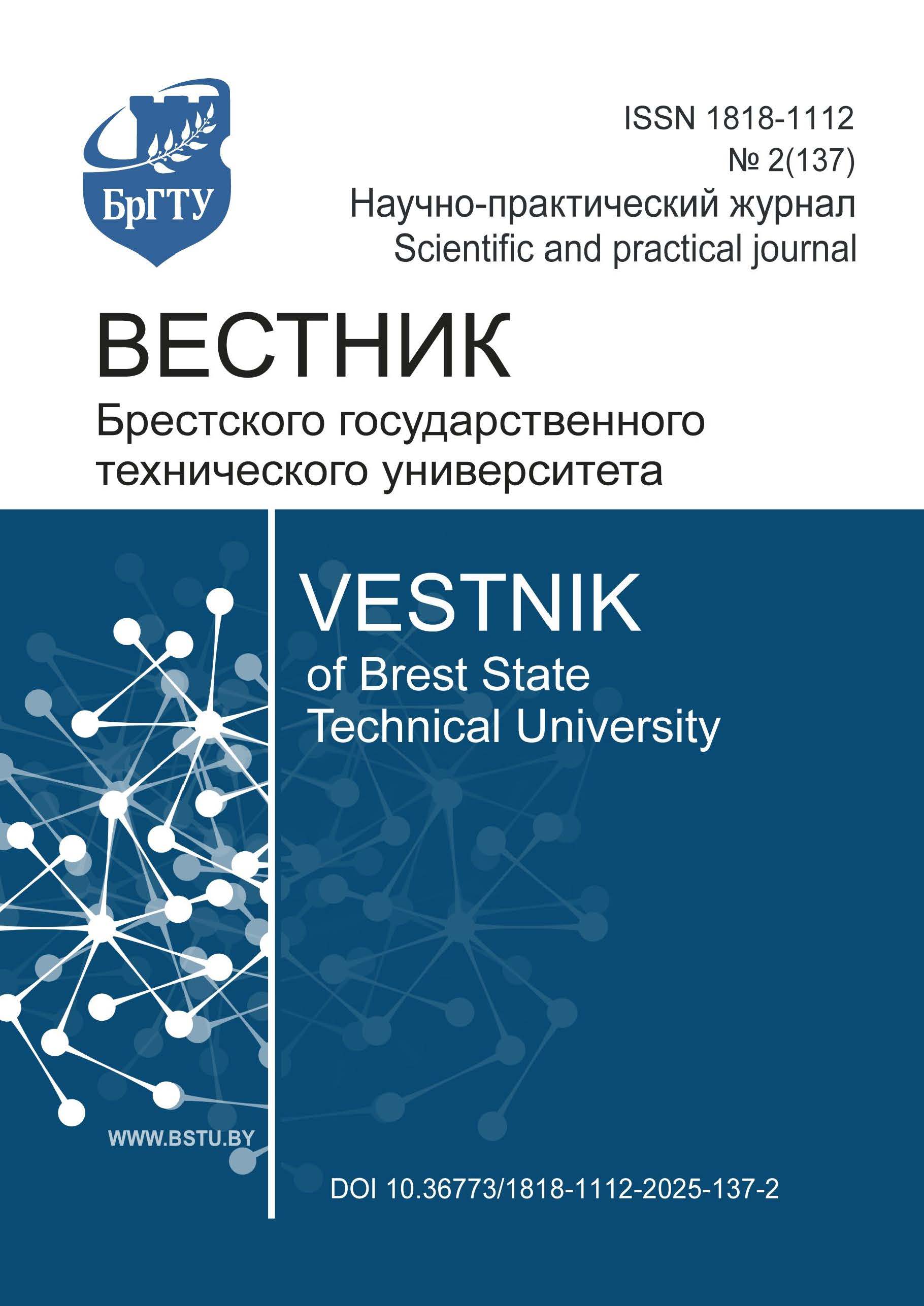ANALYSIS OF DEVELOPMENT AND GROWTH OF THE CONSTRUCTION INDUSTRY TO PROMOTE IMPROVEMENT OF QUALITY AND EFFICIENCY OF THE NATIONAL ECONOMY OF THE REPUBLIC OF BELARUS BASED ON THE VAR MODEL
DOI:
https://doi.org/10.36773/1818-1112-2025-137-2-159-165Keywords:
construction industry, investments, economic growth, construction and installation works, housing construction, construction organizationsAbstract
The article is devoted to the analysis of the dynamics and structural features of the construction sector of the Republic of Belarus, as well as its impact on the national economy for the period 2014–2023. The research aims to conduct a comprehensive assessment of the construction sector's development, identify key factors determining its functioning, and define its role in ensuring the quality and efficiency of the Belarusian national economy.
To achieve this goal, the study employs a comprehensive methodological approach, including the analysis of statistical data on key indicators of the construction industry (dynamics of contract work volumes, structure and volumes of investments, number of construction organizations, housing commissioning) and econometric modeling based on a Time-Varying Vector Autoregression (TV-VAR) model. The key variables selected for modeling were the GDP of the Republic of Belarus, the volume of construction contract work, fixed capital investments allocated to construction, the share of construction investments in total investment capital, and the physical volume index of construction and installation works.
The analysis of current trends revealed periods of dynamic transformations in the Belarusian construction industry, including the impact of state modernization programs and fluctuations in the sector's share of GDP. The significant role of the state as a regulator and customer was noted, as well as changes in the number of construction organizations and the volume of contract work, including capital and current repairs, at the regional level. The dynamics of investments in construction and installation works and housing commissioning were also analyzed.
The research findings can be useful for forming effective investment policies, forecasting construction activity, and developing measures to enhance the industry's competitiveness.
References
Economic and Mathematical Model for Decision-Making in Resource Management of an Organization / A. L. Akhtulov, L. N. Akhtulova, A. V. Leonova, A. V. Ovsyannikov // Omsk Scientific Bulletin. – 2015. – No. 1 (135). – P. 168–172.
Critical success factors (CSFs) for integration of sustainability into construction project management practices in developing countries / S. Banihashemi, M. R. Hosseini, H. Golizadeh, S. Sankaran // International Journal of Project Management. – 2017. – Vol. 35, No. 6. – P. 1103–1119.
Begum, R. A. Waste generation and recycling: Comparison of conventional and industrialized building systems / R. A. Begum, S. K. Satari, J. J. Pereira // American Journal of Environmental Sciences. – Vol. 6, No. 4. – P. 383–388. – DOI: 10.3844/ajessp.2010.383.388.
Construction Statistics. – URL: https://dataportal.belstat.gov.by/osids/ rubric-info/1063384 (date of access: 04.05.2025).
Additive manufacturing as an enabling technology for digital construction: A perspective on Construction 4.0 / F. Craveiro, J. P. Duarte, H. Bartolo, P. J. Bartolo // Autom. Constr. – 2019. – Vol. 103. – P. 251–267.
The government-production nexus of energy efficiency in China’s construction industry: Regional difference and factor analysis / X. Feng, R. Q. Jin, Y. H. Chiu, L. A. Zhang // Environ. Sci. Pollut. Res. – 2023. – Vol. 30. – P. 106227–106241.
Gelrud, Ya. D. Vector Autoregression Model of Production Performance Indicators for a Construction Enterprise / Ya. D. Gelrud, E. A. Ugryumov, V. L. Rybak // Bulletin of South Ural State University. Series: Computational Mathematics and Informatics. – 2018. – Vol. 7, No. 3. – P. 19–30.
Impact of knowledge management capabilities on organizational performance in construction firms: The mediating role of innovation / H. Idrees, S. A. Haider, J. Xu [et al.] // Measuring Business Excellence. – 2023. – Vol. 27, No. 2. – P. 322–340.
Investment Statistics in Fixed Assets. – URL: https://dataportal.belstat.gov.by/osids/rubric-info/1063385 (date of access: 04.05.2025).
Key Indicators for the Republic of Belarus. – URL: https://www.belstat.gov.by/ofitsialnaya-statistika/osnovnye-pokazateli-po-respublike-belarus/ (date of access: 04.05.2025).
Lessing, B. Main factors causing delays in large construction projects: Evidence from New Zealand / B. Lessing, D. Thurnell, S. Durdyev // Journal of Management Economics and Industrial Organization. – 2017. – Vol. 1, No. 2. – P. 63–82.
Li, J. Blockchain in the built environment and construction industry: A systematic review, conceptual models and practical use cases / J. Li, D. Greenwood, M. Kassem // Automation in Construction. – 2019. – Vol. 102. – P. 288–307.
The Effect of Disruptive Technologies on Facilities Management: A Case Study of the Industrial Sector / K. Michell, N. Brown, J. Terblanche, J. Tucker // In Construction in 5D: Deconstruction, Digitalization, Disruption, Disaster, Development; Springer: Berlin/Heidelberg, Germany. – 2022. – P. 113–123.
Validating green building social sustainability indicators in China using the fuzzy delphi method / M. L. Tseng, S. X. Li, C. W. R. Lin, A. S. F. Chiu // Journal of Industrial and Production Engineering. – 2022. – P. 1–19.
Xiaowu, D. Evaluation on the High-quality Development of China’s Construction Industry Based on the lnnovation-driven Way / D. Xiaowu, S. Xushan, D. Zhonghui // Journal of Xi’an Shiyou University (Social Science Edition). – 2022. – Vol. 31. – P. 39–47.
Average propagation length analysis for the change trend of China’s construction industry chain / Z. Yang, G. Guan, H. Fang, X. Xue // Journal of Asian Architecture and Building Engineering. – 2021. – Vol. 21. – P. 1078–1092.
Zhang, S. Construction site safety monitoring and excavator activity analysis system / S. Zhang, L. Zhang // Construction Robotics. – 2022. – Vol. 6. – P. 151–161.
Zhong, J. Impact of financial development and its spatial spillover effect on green total factor productivity: evidence from 30 Provinces in China / J. Zhong, T. Li // Mathematical Problems in Engineering. – 2020. – P. 1–11. – DOI: 10.1155/2020/5741387.
Zubarev, A. V. Building a GVAR Model for the Russian Economy / A. V. Zubarev, M. A. Kirillova // HSE Economic Journal. – 2023. – Vol. 27, No. 1. – P. 9–32.
Zuofa, T. Appraising knowledge management perceptions among construction practitioners / T. Zuofa, E. Ochieng, A. Burns // Proceedings of the Institution of Civil Engineers-Management, Procurement and Law. – 2015. – Vol. 168, No. mp2. – P. 89–98.
Downloads
Published
How to Cite
Issue
Section
License

This work is licensed under a Creative Commons Attribution-NonCommercial 4.0 International License.
The work is provided under the terms of Creative Commons public license Attribution-NonCommercial 4.0 International (CC BY-NC 4.0). This license allows an unlimited number of persons to reproduce and share the Licensed Material in all media and formats. Any use of the Licensed Material shall contain an identification of its Creator(s) and must be for non-commercial purposes only. Users may not prevent other individuals from taking any actions allowed by the license.










